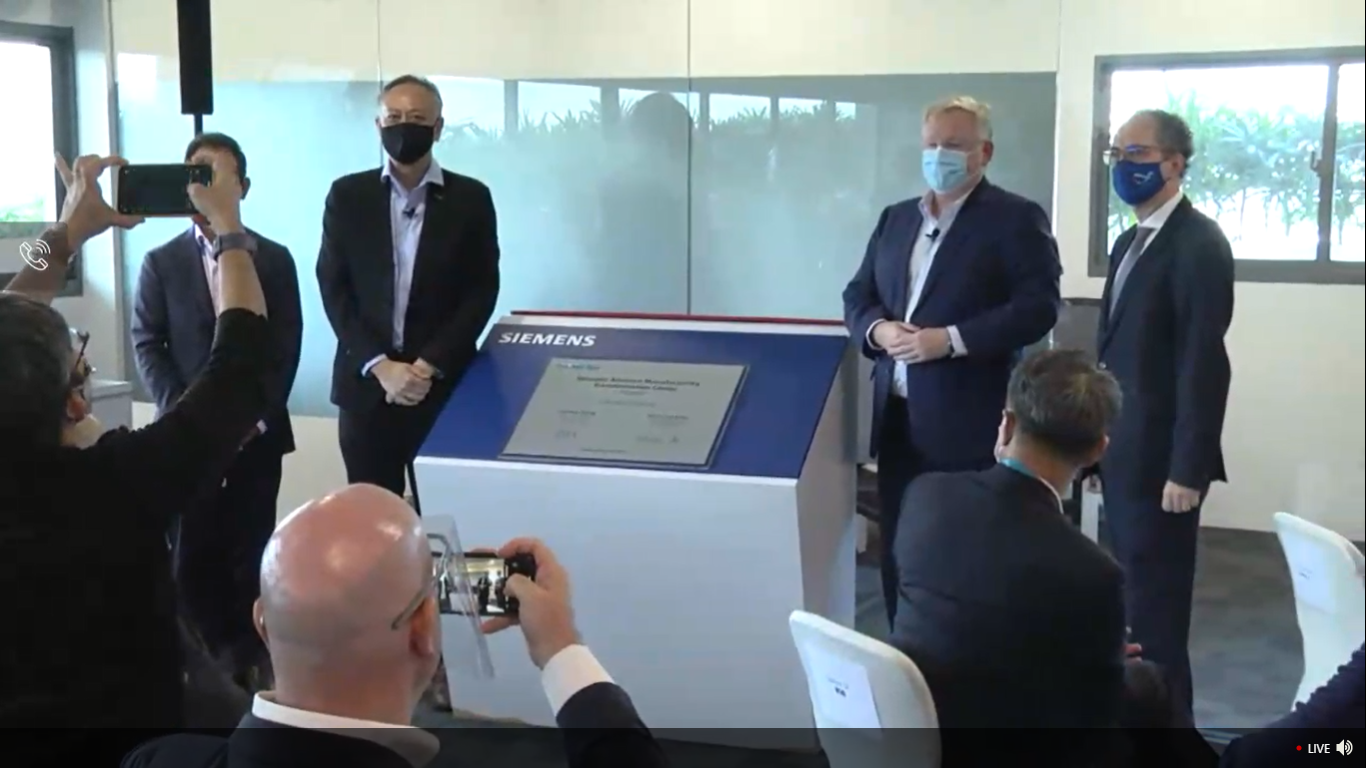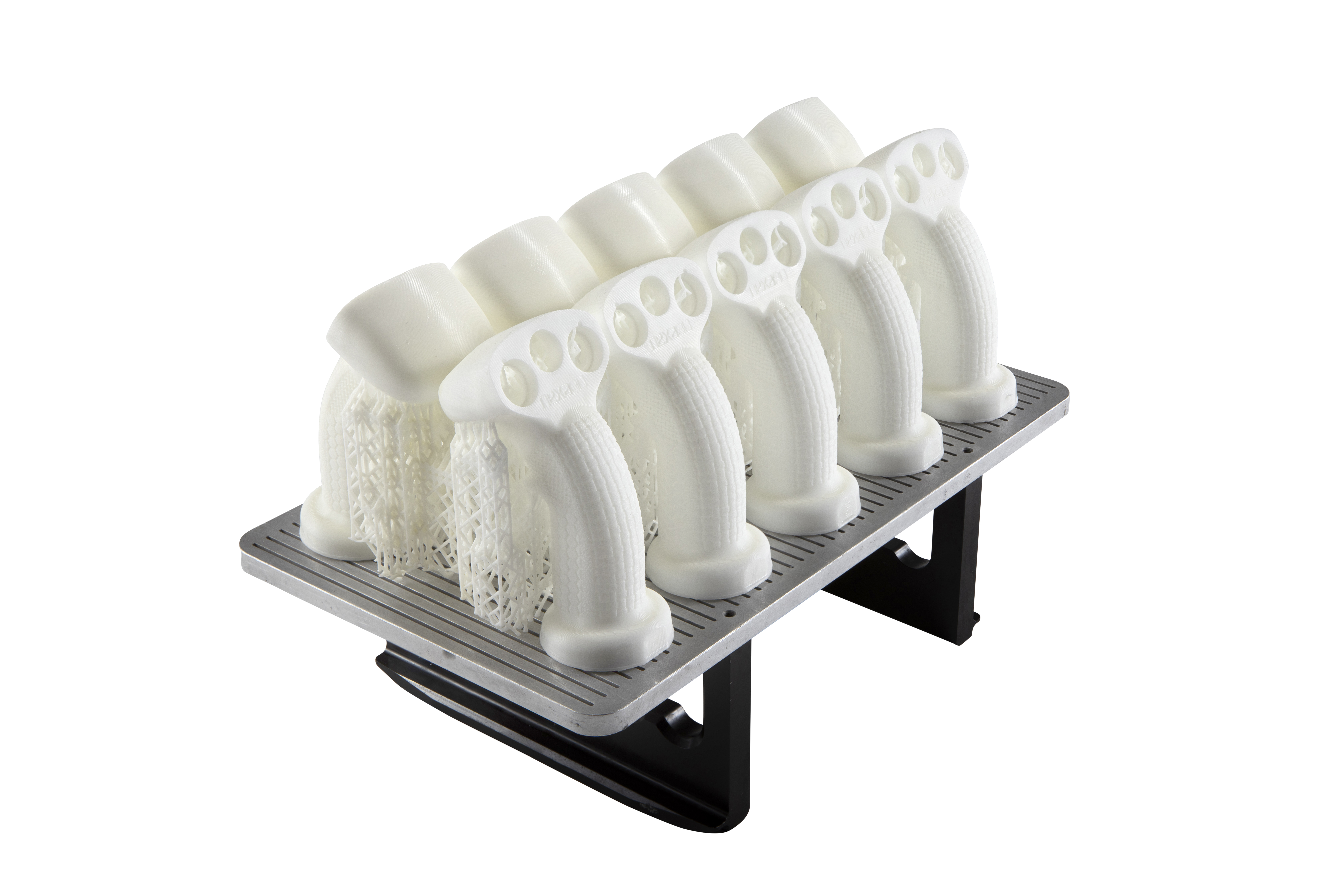Ultrafast polymer production 3D printer manufacturer, Nexa3D, has partnered with Royal DSM to speed up the adoption of sustainable additive manufacturing and production.
The partnership will fast track the availability of Nexa3D’s Quantum Laser Sintering (QLS) 350 systems with DSM’s sustainable laser sintering powders for series production. In addition, DSM’s first polybutylene terephthalate (PBT) laser sintering material, Arnite T AM1210, will be included with every QLS 350 system sold commercially from the first quarter of 2021.
According to DSM, Arnite T AM1210 is the first-ever PBT powder commercially available for series production of industrial and automotive electronics.
“We are very excited to partner with Nexa3D, the company that is breaking traditional additive manufacturing speed and productivity barriers, to deliver our first-ever PBT laser sintering material through their ultrafast QLS 350 system,” said Hugo da Silva, VP of Additive Manufacturing at DSM.

PBT powders in additive manufacturing
Driven by innovations in the automotive and electronics industries, the use of laser sintering PBT materials is expected to increase significantly over the next decade, in part due to the need to minimize issues surrounding the corrosion of metals and their associated high costs.
Earlier this year, the Mitsubishi Chemical Corporation (MCC) and German new materials start-up company, AM Polymers GmbH (AMP), partnered to co-develop polybutylene terephthalate (PBT) powder products for industrial 3D printing using PBT feedstock, and a beta version of AMP’s Rolaserit PBT01 powder.
In January, French 3D printer producer Prodways sold two of its ProMaker P2000 ST 3D printers to DSM, allowing the company to test its powders for high-temperature SLS 3D printing. Prio to this, DSM used Prodways’ ProMaker P4500 3D printer to print Arnite T AM1210.
Arnite T AM1210 is well-suited suited to the automotive and electronics industries thanks to its electrical, mechanical, and flame-retardant properties. Developed for a wide sinter window, the powder is very easy to print, and is environmentally friendly with a reuse rate of more than 60%. Arnite T AM1210 is also recyclable to the extent that the material can be brought reused in the powder bed process.

The partnership
Nexa3D and DSM hope that their partnership underscores their commitment to accelerating the adoption of sustainable additive manufacturing for series production of electrical connectors, automotive electronics, and lighting applications.
“As we have already witnessed throughout Covid-19, the manufacturing industry sees AM as a viable path to sustain production and build resilient supply chains,” da Silva continued. “This requires accelerated adoption of AM technology and at DSM, we are moving quickly to introduce new materials and collaborate with partners whenever possible.”
According to Avi Reichental, co-founder and CEO of Nexa3D, the collaboration aims to unlock the full potential of additional performance polymers for additive manufacturing.
“We are thrilled to partner with a company of the caliber of DSM, one of the world’s leading providers of additive manufacturing performance polymer to jointly deliver the next generation of series production capabilities to our customers,” he said. “We believe that this collaboration is essential given our combined capabilities to improve polymer production performance orders of magnitude and that this is the right time to realize the combined potential that this partnership unlocks for the benefit of our expanding customer base in the innovative automotive and electronic industries.”

Automating additive manufacturing
Nexa3D has also announced a partnership with technology powerhouse Siemens to bring its additive manufacturing production systems up to full Industry 4.0 ‘preparedness’.
The collaboration will see Nexa3D’s entire QLS product line standardized to Siemens’ factory automation and edge computing technologies, with commercial delivery of its QLS-350 polymer production 3D printer, powered by Siemens’ automation controls, in the first quarter of 2021.
“We are very pleased to join forces with Nexa3D and together unleash the power and potential of our products to create more resilient and sustainable supply chains,” said Tim Bell, head of additive manufacturing at Siemens Industry. “Working with Nexa3D, we are bringing decades of proven Siemens factory automation experience and technology to additive manufacturing to help customers mainstream mission-critical production tools for future manufacturing strategies.”
Industry 4.0 and additive manufacturing
Industry 4.0, known as the ‘fourth industrial revolution’, refers to the adoption of interconnectivity, automation, machine learning, and real-time data. The need for companies to digitalize and optimize their operations to achieve Industry 4.0 has been a trend for some years, and has become highlighted further by supply chain flaws highlighted during the Covid-19 pandemic.
Last week, Siemens opened its Advance Manufacturing Transformation Center (AMTC) in the western part of Singapore in Tuas, a one-stop advanced manufacturing ecosystem facilitating the transition into 3D printing and Industry 4.0. The AMTC has been set up to bridge the gap between prototyping and industrial production of additive manufacturing, as well as guiding companies through their digital transition.
“Covid-19 has underlined the incredibly rapid and flexible nature of our combined factory automation technologies and additive manufacturing capabilities compared to traditional manufacturing and demonstrates how vulnerable the global manufacturing supply chain is to unexpected disruptions,” Bell continued.

The collaboration
Siemens and Nexa3D will work together to combine connectivity digital twin sensing and data acquisition in order to deliver 24/7 predictive maintenance, process monitoring, and print optimizations, in order to facilitate polymer additive manufacturing solutions at scale.
“We are very excited to partner with Siemens, the world’s leading provider of factory automation and digitization technologies, to jointly deliver the next generation of manufacturing capabilities to our customers,” said Kuba Graczyk, head of thermoplastic additive business at Nexa3D. “We believe that this collaboration is essential given the strengths of the 3D printing industry as demonstrated throughout the Covid-19 pandemic, and this is the right time to realize the combined potential that this partnership unlocks for the benefit of our expanding customer base.”
Unveiling the xCE-White
Nexa3D has also announced the immediate availability of its new photoplastic material, xCE-White, a functional polymer for producing end-use plastic parts and injection molding tools.
The fastest single cure material in the company’s portfolio, xCE-White facilitates additive manufacturing productivity increases twenty-fold, and is developed for Nexa3D’s NXE400 3D printer. The material can be used to produce isotropic parts suitable for a variety of automotive parts, automation and robotic assemblies, and other industrial components, at speeds similar to those of injection molding processes.
“We are very excited to bring to market our fastest functional photoplastic material yet, underscoring Nexa3D’s commitment to providing our customers with the highest levels of design agility and supply chain resiliency both now and post-Covid-19 that produce functional parts literally within minutes,” said Michele Marchesan, chief growth officer for Nexa3D. “With xCE-White available through our rapidly expanding global reseller network, we a re delivering a new performance photoplastic that is ideal for many production parts in addition to being an outstanding injection molding material.”

Properties and applications
xCE-White is a lightweight, sturdy material designed to withstand load, pressure, and temperature. After testing, the Nexa3D team found the material had excellent thermal stability, making it suitable for a range of automotive, electronics, and industrial components, such as brackets, pulleys, gears, and robotic devices.
The material can also be used to produce injection molding tools for thermoplastic polymers including PP, PE, HDPE, and PETG. Molds printed from xCE-White were successfully injected hundreds of times at temperatures between 230-280 degrees celsius, without exhibiting visible degradation or adhesion.
Nominations for the 2020 3D Printing Industry Awards are still open, let us know who is leading the industry now.
The fourth edition of the 3D Printing Industry Awards Trophy Design Competition is now underway. Enter your design for the chance to win a CraftBot Flow 3D printer.
To stay up to date with the latest 3D printing news, don’t forget to subscribe to the 3D Printing Industry newsletter or follow us on Twitter or liking our page on Facebook.
Are you looking for a job in the additive manufacturing industry? Visit 3D Printing Jobs for a selection of roles in the industry.
Featured image shows Arnite T AM1210 (P) Square. Image via Nexa3D.


